Over the years, I’ve solidified how I keep track of my embroidery journey – whether it’s ideas I’m trying to develop, designs I’m working on, projects and their materials, mistakes and adjustments, and so forth.
While my website Needle ‘n Thread is probably the most thorough record of my journey, I keep lists and notes while I work through projects, and all of these lists, notes, designs, ideas, adjustments, and what-have-you end up in a project notebook.
Still, with each project or each idea, I still find small adjustments that I make in the information that I record and my methods of recording it.
Keeping these notes and tidbits of information all in one place helps me in numerous ways, not just in developing ideas for projects, but also in answering your questions, ordering supplies, or simply remembering!
Lately, I’ve started adding real-thread color cards to my project notes. Let’s look at The What, The How, and The Why!
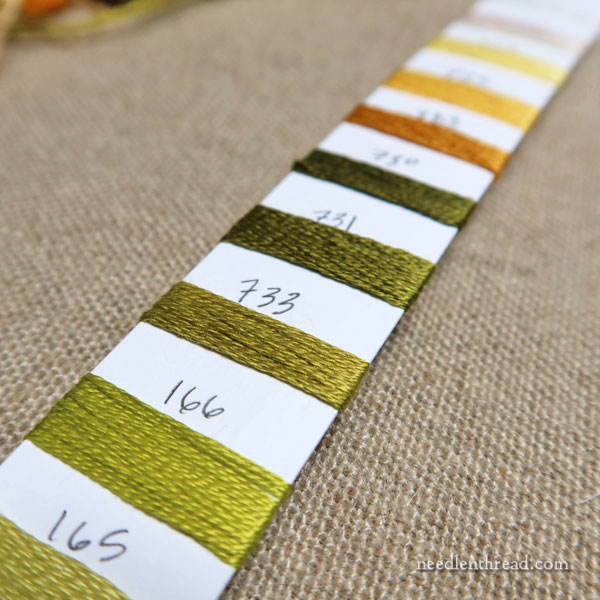
A real-thread color card is a card with real thread on it.
Manufacturers of threads often produce real-thread color cards so that designers, retailers, and consumers can see real samples of threads in their true colors, rather than relying on printed blocks of color to make decisions about threads.
In a nutshell, the reasoning is simple: color on thread looks and performs differently from color on paper. You will have a much better understanding of a color of thread when you see the actual thread, rather than a printed representation of it. (We won’t go into the nitty-gritty of print processes, digital representations, and so forth – I’m sure it is obvious that the real thread will give us a better understanding of its color than any printed or digital representation would give us.)
Lately, with my projects, I’ve started keeping very simple real-thread color cards with them.
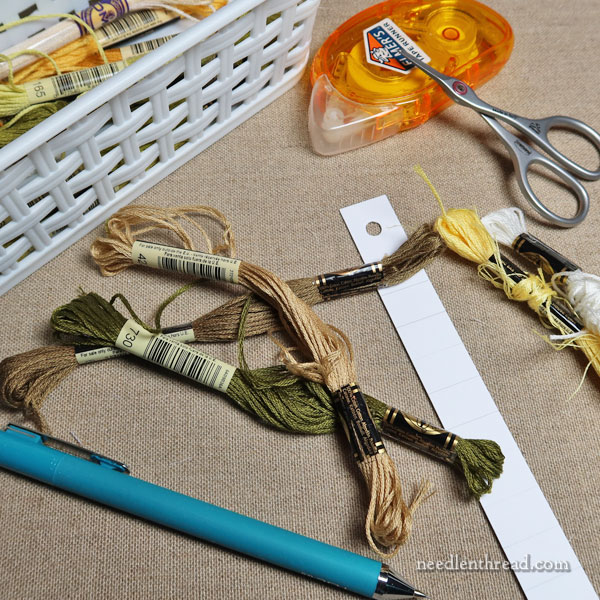
It’s quite simple to make up the color cards.
I cut 3/4″ strips of heavy card stock, in white. The card strip might be long – the one I’m using here is 8″ – or it might just be a 2″ or 3″ strip.
At first, I was measuring 1/2″ intervals on those strips (and I still do this for some applications – but that’s a Whole Different Article which we will get to a little later – I’ve got a fun organizational project going on that I can’t wait to share with you!).
For these project-specific color cards, I’ve found that I don’t really need to measure intervals between the threads, as long as I leave enough space to write the thread colors in.
At first, I used strip glue (the Elmer’s stuff you see in the photo above) but I ran out, and I started using double-sided tape on the back of the card stock strip. I find the latter works better.
I use a pencil or pen for recording color numbers on the strip.
At the top of the strip, I write the name of the project and the thread type for that particular card. If all the threads are the same manufacturer, I write the manufacturer. If I’m using threads from different manufacturers, I make a different card for each manufacturer.
The card I made up here is for the Daisies project we started the other day. All the threads are DMC, so I wrote “Daisies” at the top, and “All DMC.”
When the thread is a different type of thread from the same manufacturer (like perle cotton instead of stranded cotton), I’ll use abbreviations like “P#12” for “Perle #12” followed by the color. On this card, the top thread is P#12 blanc. So I know it is DMC perle cotton #12 in blanc.
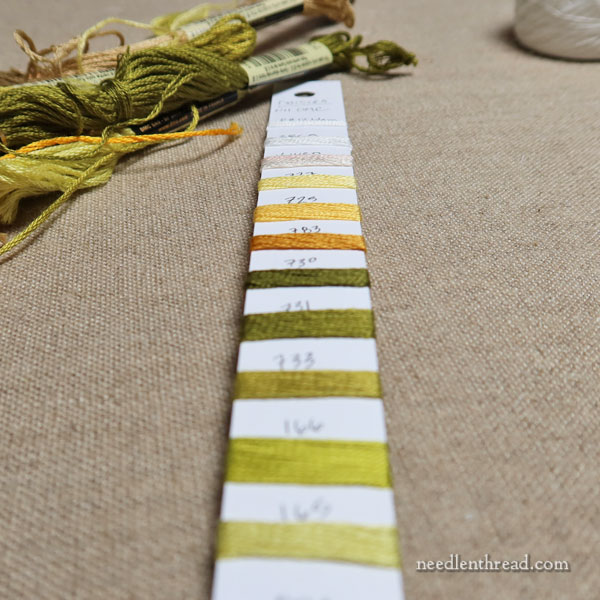
When the project was finished and all my thread choices absolutely solidified, I used mostly scraps (pre-cut pieces I didn’t use all of, for example) and wrapped the bits of thread around the strip of card stock, leaving space to record the color number.
I put a tiny piece of double-sided tape on the back of the card strip where the thread would be wrapped, to hold the thread in place.
I used approximately 5-6″ pieces of thread and wrapped around the card about 4-5 times – sometimes a little more, or less, depending on the actual length of the cut piece I had on hand. You definitely want several wraps on the card, because you want the color block to be very clear. If you have to use it for reference later, it’s easier to compare other things to a larger block of color than to only a small bit of color.
Once the card is complete, you can either dab glue (a PVA glue is a good choice) on the threads on the back of the card to further secure them, or you can run a strip of archival tape down the back of the card over the threads. This helps cover any uncovered sticky bits from the double-sided tape, too.
If you’re just going to put the whole thing in a notebook, though, you don’t really have to worry about covering sticky bits, and the double-sided tape will hold the threads well.
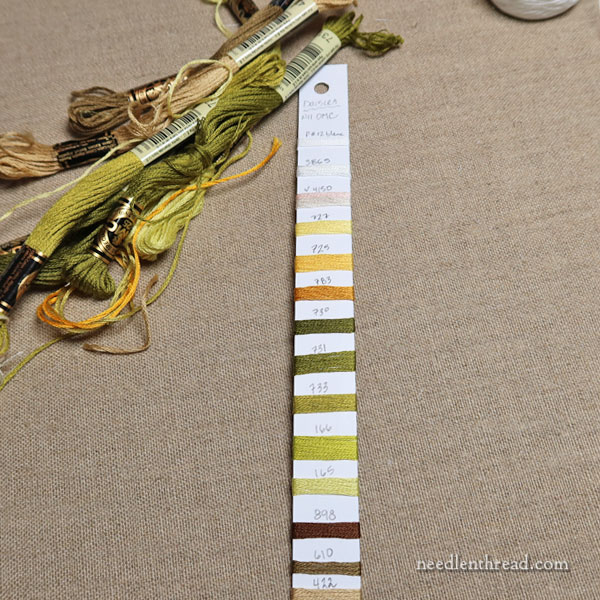
This card represents all the colors and threads used in the Daisies project.
Why?
Do you need to make real-color thread cards that are project specific?
You might not need to. You might not want to.
But you might want to, even if you don’t need to. I know many people who keep track of their projects with notebooks and keep scraps of each type of thread and fabric and whatnot tucked in the notebook. It gives them a sense of ownership over the project, a sense of organization, of progress, and finally of satisfaction upon completion.
Is it essential? It depends on what you’re doing.
For me, keeping project-specific real-thread color cards is extremely helpful for several reasons.
I find it helpful to see, at a glance, the specific colors I used. If I want to repeat those colors, if I want to find them in my thread drawers or if I want to order them, it is nice to see them and not just refer to a number.
It is invaluable when it comes to cross matching threads for conversion.
What do I mean? Say I used a certain color of stranded cotton in a project, but now I want to work it in silk – or visa-versa. Or maybe I like the color scheme a lot and I want to use the same color scheme in a crewel project. Having a real-thread color card makes it really simple to find thread conversions for the crewel wools I want to use.
And finally – perhaps not as important, but still legitimate – it establishes a much more complete documentation of the project for my own future reference, or just for the satisfaction of having a thorough documentation of all the supplies I used.
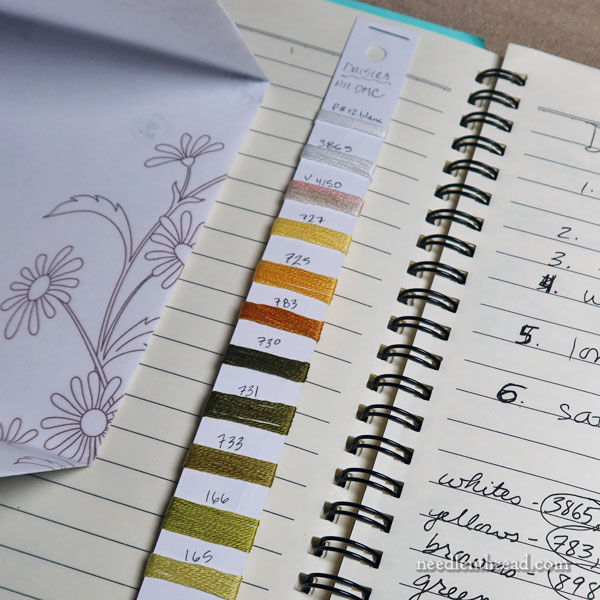
The color strip (or strips, depending on the project) are stapled into my notebook with all the notes on that particular project.
So, if you like to track your projects, this might be a great addition to your project notebook. It doesn’t take any time at all, really. I do it right when I’m doing the project clean-up, as part of the sorting and clean-up process.
Later on, I’ll show you a completely different thread organization project that I’m enjoying. I always find certain organizational projects to be relaxing and at the same time, purposeful. So more on that project soon!







Mary,
Thank you so much for sharing this. Even if documenting our work may not be necessary for all of us, keeping a record of our process becomes a wonderful journal to re-read and appreciate our growth in design, skill, and patience.
Beth B
I wish I’d done this with one of my earliest projects. It was a cross stitch project that could be stitched in any color(s), and I just played around with whatever colors caught my eye at the time.
Life got in the way, I put the project down and got my floss tidied away and now I can’t remember which colors I used. I’d wanted the various colors to be similar throughout, but my floss collection has grown so huge I just don’t remember what I used back then. Such a headache.
Dear Mary
Real thread cards are great I have the Soie d’Algar thread card catalogue and it is lovely. As you say it makes it easier to choose the colour threads for a project. I like your idea of creating a real thread card and attaching it to the notebook with the information on the project that is so useful if you want to refer back to a particular project. Thank you for sharing with us how to create a thread card, this is a great way of storing embroidery information.
Regards Anita Simmance
Love this concept and the thread log you told us about years ago. I was never able to access the thread inventory mentioned in the thread log post but found an alternative that I love that might be helpful to you and others. I do cross-stitch also which is how I found this app called XStitch Plus. There is a small annual fee but totally worth it for me. The app allows you to inventory your threads, dozens of types and brands. I haven’t run across a floss or thread I haven’t been able to inventory but also don’t use a huge variety of flosses and threads. You can add missing flosses to a shopping cart straight from the inventory lists. Also able to inventory beads, buttons, linens, and x-stitch charts. Am able to “journal” the charts and list which are “kitted” and ready to stitch, which I have “ started” and when and which I have “finished” and that date. Photos can be added to everything. For cross-stitchers there is also a calculator for figuring the size linen you need for your chart – you plug in the thread count and a couple other small details and it does the math. Syncs across all my devices.
Mary,
I do something similar, but I don’t glue the thread. I had made a blouse with embroidery and a bit of the embroidery got snagged by a rose. As luck would have it, in my notebook, I had a card with the thread. I was able to do the repair.
I make a strip and punch it on one side for the binder and on the other for the threads. I leave a standard length of thread for each color. And I write the manufacturer and the color name or number.
One of the reasons I dislike kits with thread added, is often there’s no extra thread included!
Of course, once some of my napkins have been through the wash for a year, the thread doesn’t always still match. But I figure in time, it will all work out.
I love this idea! Thanks for sharing!
Fabulous information. Will definitely use this idea in the future. Thanks Mary
I’m hopeless. Not only have I never documented anything. It’s never even occurred to me. Though I did write colour numbers onto a sketch of the central panel of my current project.
I suppose it does mean you have to be sure to keep pieces of thread. Sometimes I’m using the last bit of it!
Still, it would be nice to have a record, especially of projects I’m not keeping.
I guess I’d like to have the record without needing to keep stopping to do the recording!
I can see this would also be helpful to help sort out colors when you have colors that are very similar — and you have a wad threads to pull from as you are working on a project. So simple – but so smart!
I had to send thread samples and detailed notes for each step of my Master Craftsman in Surface through EGA.
It was a great habit to get into, and one I do regret not continuing.
Thanks for the reminder.
OH this is so great! I feel rather dumb for making satin stitches onto cotton muslin and then attaching them onto cards now haha. Taping is so much faster.
Kokuyu, Tombow and probably a bunch of others I’m forgetting make these glue tape that come in a dispenser which are really convenient.
I know you mean it for a specific project, but I have been doing this for all my threads to make real thread color cards since a bunch of them don’t have real thread cards or are out of stock (cough DMC), and I like the flexibility of looking at all the colors and pulling out individual colors to see how they work together.
That said, good reminder – I really should track my projects better…
Mary, would you please post a picture of your notebook. What type and size do you like to use?
Thank you,
Barbara La Belle
Wow!
I’ve got nothing else to say.
Very nice explanation of not only how to do this but the reasons why a person might want to keep track of the exact threads used in a piece. Thank you.